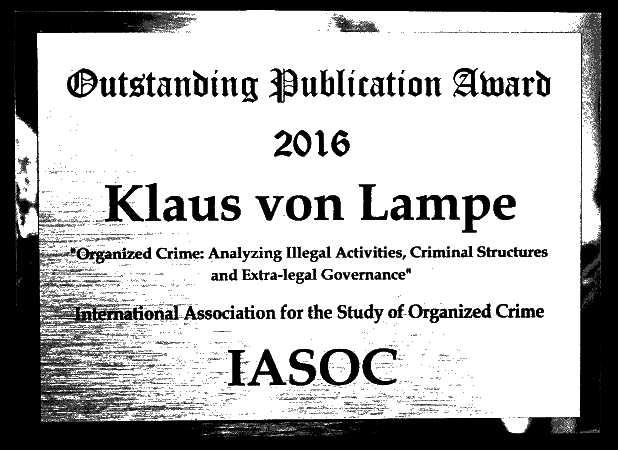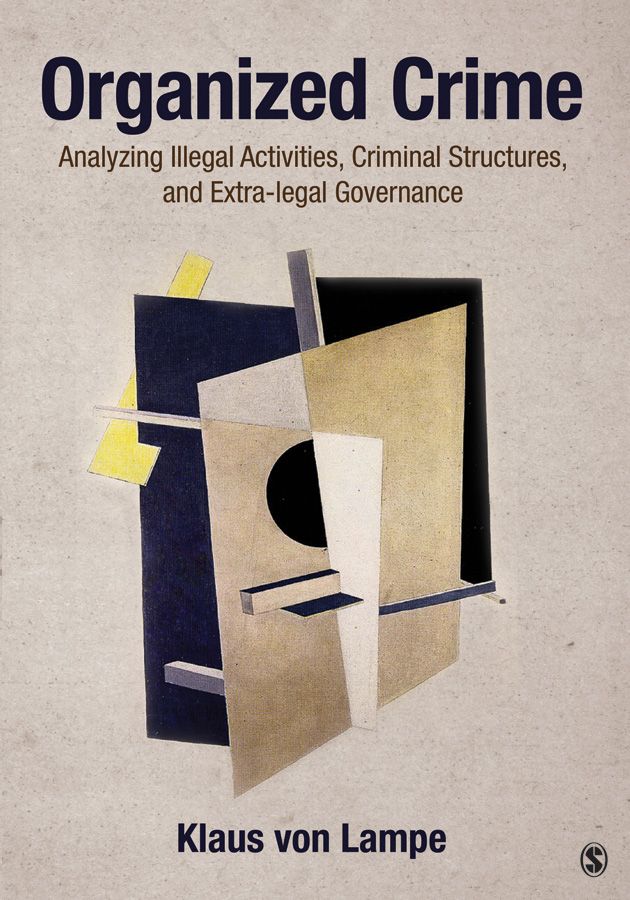
Klaus von Lampe
Organized Crime: Analyzing Illegal Activities, Criminal Structures, and Extra-legal Governance
Thousand Oaks, CA: Sage, 2016
488 p.
ISBN 978-1-4522-0350-8
 2016 Outstanding Publication Award (IASOC)
2016 Outstanding Publication Award (IASOC)
“a major contribution to the literature”
"a really impressive book"
"very interesting, thorough, and up-to-date review of the literature on organized crime"
“by far the most comprehensive and thoughtful treatment of the subject matter”
"most definitely the ultimate textbook on organized crime"
“the most compelling composite of this social and economic phenomenon known as organized crime"
"provides a conceptual framework for the future study of organized crime"
“accessible and detailed ... a kind of hybrid textbook-monograph ... highly recommended”







Preface:
This book provides a systematic overview of the processes and structures commonly labeled organized crime, drawing on the empirical and theoretical literature on the subject from a broad range of academic disciplines, including criminology, sociology, economics, and political science. The book is global in scope in that the discussion is not limited to any specific country or region in the world, although it incorporates insights and findings mainly from scholars based in North America, Europe, and Australia.
This book is not supposed to be just another text on organized crime. Conventional textbooks on organized crime are primarily descriptive. They are structured along the lines of particular criminal groups and areas of crime, and they incorporate theory primarily in terms of established criminological theories. Classifications tend to be based on superficial criteria, such as the ethnic make-up or the geography of criminal groups, while neglecting underlying similarities and differences. In so doing, these texts fail to take account of the increasing level of sophistication the study of organized crime has attained globally as a serious scientific, multidisciplinary endeavor in terms of conceptualization, theorizing, and empirical research.
In contrast to the existing textbook literature, this book adopts a more analytical approach by placing the main emphasis on underlying patterns and dynamics that transcend any specific historical manifestations of organized crime. It seeks to lay out a general conceptual and analytical framework that captures the multifaceted and dynamic nature of the organization of crime and criminals across different social, economic, and political contexts.
Throughout the book, notorious and less well-known cases are examined in detail to provide concrete empirical reference points for the discussion. No attempt is made to comprehensively and exhaustively describe all past or current organized crime phenomena. Empirical manifestations of organized crime are described in detail only selectively and only insofar as they represent prototypical or ideal-typical examples that serve to illustrate particular dimensions and categories.
However, readers will find references to further academic literature that deals with aspects that are given only scant attention in this book. The structure of the book is such that the complexities of the phenomena labeled organized crime are broken down into key dimensions and categories. The book follows a distinction of three basic dimensions: (a) illegal activities, (b) patterns of interpersonal relations that are directly or indirectly supporting these illegal activities, and (c) overarching illegal power structures that regulate and control illegal activities and the individuals and groups involved in these activities. Organized crime phenomena are examined along these lines, first in their own right and then in a broader societal and transnational context, particularly with a view to the relation between underworld and upperworld, a relation that may take on the form of confrontation, accommodation, or integration.
The Purpose of the Book
This book is intended as the core text for courses on organized crime and transnational crime on the undergraduate, graduate, and post-graduate levels. Beyond classroom use, this book is meant to serve as a reference and guide to the academic literature on organized crime for academics, intelligence analysts, law enforcement officials, policymakers, and the general public.
The starting point for this book is the assumption that organized crime is not something that lends itself easily to scientific scrutiny. It is not a coherent empirical phenomenon but first and foremost a construct, reflecting social reality as much as the emotions, prejudices, and ideologies of those involved in the construction process. Scholarly efforts have aimed at disentangling the web of imagery associated with organized crime. They have contributed to a better understanding of the underlying phenomena and have shed light on some intricate links that justify placing these diverse phenomena in a broader theoretical context. While there is little overall consistency in the research conducted within this broad field, there are certain clusters of research that have contributed to a cumulative body of knowledge around certain themes, such as illegal enterprise, certain historical phenomena, such as the Sicilian and American Cosa Nostra, or certain methodological approaches, such as criminal network analysis.
The book presents this research within a coherent framework to help readers achieve three goals:
- To understand the categorical differences and similarities between the various phenomena associated with the term organized crime in order to avoid comparing apples and oranges
- To understand the way these phenomena manifest themselves empirically in order to separate myth from reality
- To understand the various theoretical propositions that on different levels of abstraction and within different frames of reference explain key aspects of organized crime in order to gain a sense of what matters more and what matters less in the organization of crime and criminals
The Content of the Book
Any endeavor intended to contribute to a better understanding of organized crime is faced with two considerable challenges. The first challenge is to emancipate the audience from stereotypical and mythical imagery created and promoted in the media and—unfortunately—also in some of the academic literature. The second challenge is to overcome the confusion that stems in part from the diversity of conceptualizations in the public and scholarly debate on organized crime and in part from the diversity of the empirical phenomena that are associated with organized crime.
The book addresses these challenges with its emphasis on a comprehensive classificatory scheme and consistent terminology, which encompasses aspects that otherwise might be addressed only in an unsystematic, anecdotal way, only in passing or not at all. These issues include individually and in context the following:
- The modus operandi and logistics of criminal activities
- The individual offender characteristics
- The structure and dynamics of the organization of offenders
- The structure and dynamics of the organization of criminal milieus
- The interrelations between criminal activities and criminal structures and the broader social, cultural, political, and economic environment
It goes without saying that a subject as complex as that of organized crime cannot be exhaustively addressed in one book. Even the aspects that are covered in this book would lend themselves to more in-depth examination. Placing the main focus on the academic literature means that little use is made of the vast body of journalistic and official reports on organized crime. But even the coverage of the scholarly research and writing is far from complete. First of all, the book does not follow the study of organized crime in all of its ramifications. For example, with a wide audience in mind, the more sophisticated levels of criminal network analysis and the kind of abstract modeling of organized crime to be found on and off in economics journals have been consciously excluded from discussion. Second, there are practical and intellectual limits to the volume of literature that can be identified and meaningfully processed for presentation within one coherent framework. While it is true that not everything that has been published is worth citing, the author’s own limitations are the main reason why some academic work does not find proper mention. In this sense, the book is no substitute for an independent exploration of the ever-growing body of literature on organized crime. The ambition behind the book is that it can serve as a key to the study of organized crime as a serious scientific endeavor.
To find out more, please go to the webpage at Sage or visit me on ResearchGate.
